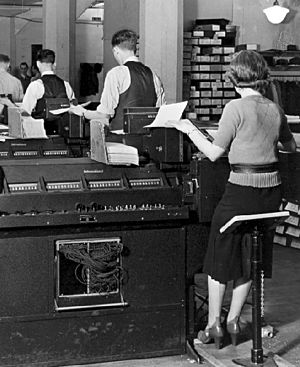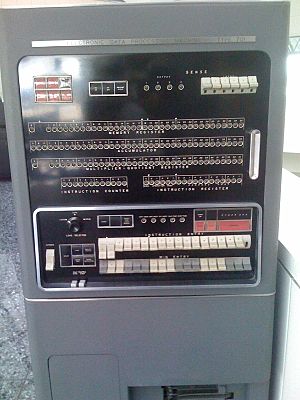Accumulator facts for kids

The accumulator is a very important part of a computer's brain, the CPU (Central Processing Unit). Think of it like a super-fast scratchpad or a special temporary storage spot. Its main job is to hold the results of calculations and other operations as the computer works. This helps the computer process information quickly and efficiently.
Contents
What is an Accumulator?
An accumulator is a special type of register inside the CPU. Registers are tiny, super-fast memory locations that the CPU uses to store data it needs right away. The accumulator is unique because it's specifically designed to hold the numbers that are being added, subtracted, or otherwise processed. It's like the main workspace for the computer's math problems.
How Does an Accumulator Work?
When a computer needs to do a calculation, like adding two numbers, it often uses the accumulator.
- First, one number might be loaded into the accumulator.
- Then, the CPU performs an operation, like adding another number to what's already in the accumulator.
- The new total or result is immediately stored back in the accumulator.
This process makes calculations very fast because the data doesn't have to travel far to be used.
A Simple Example
Imagine you want to add 5 and 3.
- The computer might first put the number 5 into the accumulator.
- Then, it tells the CPU to "add 3" to what's in the accumulator.
- The accumulator now holds the number 8.
- If you then wanted to add 2 to that, the computer would tell the CPU to "add 2" to the accumulator, and it would then hold 10.
This is a very basic example, but it shows how the accumulator helps build up results step by step.
Different Names for Accumulators
The name or specific way an accumulator is used can depend on the type of CPU and who made it. For example, in older Intel x86 computer chips, the accumulator was often called "AX" when working with 16-bit numbers. For 32-bit numbers, it was called "EAX." Even though the names change, their basic job of holding calculation results remains the same.
Why is it Important?
Accumulators have been a fundamental part of computer design since the very early days. They make it possible for computers to perform complex calculations very quickly. While modern CPUs have many more registers and advanced ways of handling data, the concept of an accumulator is still at the heart of how computers process information and perform arithmetic. It's a key component that helps your computer run programs and do everything from browsing the internet to playing games.
See also
 In Spanish: Acumulador para niños
In Spanish: Acumulador para niños


